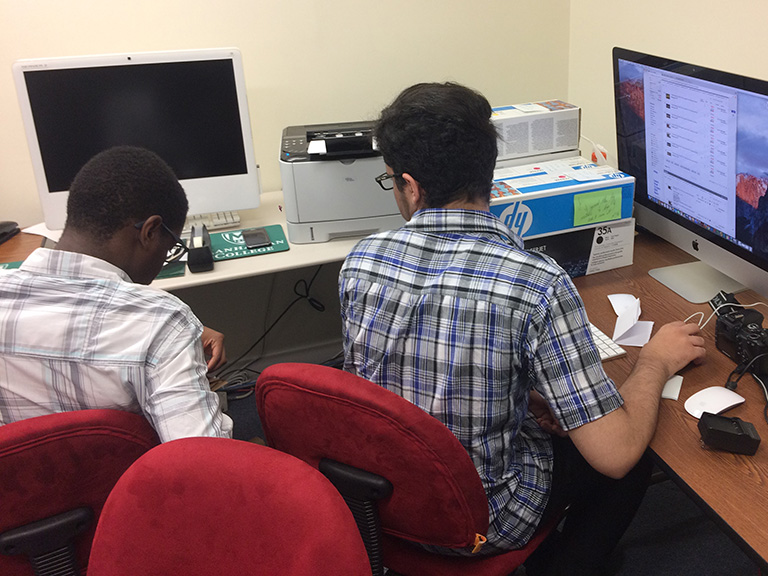 During the past three summers, high school students from the nearby In-Tech Academy, seven blocks from Manhattan College, have gathered in the fourth floor hallway of Memorial Hall, walking in and out of faculty offices, quickly moving from one task to the other.
During the past three summers, high school students from the nearby In-Tech Academy, seven blocks from Manhattan College, have gathered in the fourth floor hallway of Memorial Hall, walking in and out of faculty offices, quickly moving from one task to the other.
Under the mentorship of Shawna BuShell, Ed.D., assistant professor of education and the director of the Instructional Design and Delivery program, In-Tech students tackle learning in STEM (science, technology, engineering, mathematics) areas, integrating technology into all areas of teaching and learning. The students have created short instructional video clips, designed interactive PowerPoints and lessons with 3D printers for aspiring teachers, and worked on online courses to ensure clear, concise content for students and faculty.
Along the way, the students learned more about what it means to be on a college campus, gained daily mentorship from current Manhattan College students who have graduated from their high school, and acquired valuable skills that they can continue developing in the future.
 “I am now considering being a video game designer or a coding designer for a career,” said Kevin Menchen, one of the In-Tech Academy students. “Dr. BuShell showed me a program to build interactive tests for faculty which helped me understand the fundamentals of coding.”
“I am now considering being a video game designer or a coding designer for a career,” said Kevin Menchen, one of the In-Tech Academy students. “Dr. BuShell showed me a program to build interactive tests for faculty which helped me understand the fundamentals of coding.”
Current Students Mentor High Schoolers
Not only do the high school students receive guidance from BuShell and other faculty in Manhattan’s School of Education and Health, there is a growing pipeline of current Manhattan College students who were once in the same place as the In-Tech students, interning over the summer and then choosing Manhattan College as their first choice of college destinations.
A freshman in the School of Business, Samantha Reyes ’21 had worked for BuShell during the summer of 2016. That summer, Reyes learned how to create a syllabus for a graduate-level course, and put together a proposal on how to redesign a website for a local company.
Alejandro Furniel ’20, a sophomore in the School of Engineering, is another example of the program’s interdisciplinary approach. Furniel used the knowledge he’s obtained as a civil engineering major to design a smart classroom in Miguel Hall that opened at the start of the 2016 fall semester.
“I’ve learned to use software that I didn't even know existed,” Furniel explained. “In terms of instructional design and delivery, I’ve gained the confidence to be able to speak effectively to people, explain my goals and aspirations and become a better communicator.”
The interdisciplinary model that serves as BuShell’s framework for community service evidently carries over to those who ultimately chose to continue their studies at Manhattan College.
“I think it's truly Lasallian,” BuShell says. “Our program is not this one thing where we run into the community, do something for half an hour and come back. For three years, these kids have learned how to be professional, active in their learning, and have challenged themselves beyond their imaginations. It is an amazing experience to work with them.”
Next summer, BuShell plans to expand the opportunities for a new group of high school students, seeking to collaborate with the College’s study abroad program and with more faculty across the College’s six different schools.